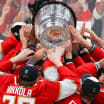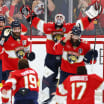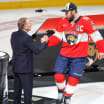INTANGIBLES
Datsyuk's greatest strength is his versatility. Whether it's in the faceoff circle, in the shootout or drawing penalties at critical moments, he has the ability to win games with a single play.
Datsyuk has won 7,444 of 13,822 faceoffs in his NHL career, a percentage of 53.8 percent. Winning draws is not a skill players lose as they age, as attested to by Datsyuk's 53.7 faceoff winning percentage in 2015-16.
As for the shootout, Datsyuk has scored 40 goals in 98 career attempts. Two players have outscored Datsyuk in the shootout since it was introduced in the 2005-06 season: Frans Nielsen of the New York Islanders (42) and Radim Vrbata of the Vancouver Canucks (41).
Datsyuk's speed and positioning sometimes can give opponents no choice but to risk a penalty to prevent him from scoring. As a consequence, Datsyuk has drawn 0.85 minor penalties per 60 minutes during the six seasons that this data has been recorded; he has been called for 0.29 per 60 minutes, the lowest rate on the Red Wings (minimum 70 games).
That penalty differential of 0.56 per 60 minutes is second on Detroit to Darren Helm (1.19), one of the game's best at drawing penalties.
By itself, each one of these examples demonstrates a key area where Datsyuk has given the Red Wings a consistent advantage.
Add them all together, and consider his more direct offensive and defensive contributions, and few players have been more valuable to their team than Datsyuk.


















